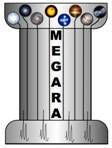Dept. Astrofísica y CC de la Atmósfera Univ. Complutense de Madrid
| Research lines:
Local star-forming galaxies Galaxy models Surveys Databases SHARDS project Stellar libraries Early-type galaxies Meteors and Fireballs Dark Skies |
Instrumental developments: MEGARA:Multi-Espectrógrafo en GTC de Alta Resolución para Astronomía |  |
| EMIR: Espectrógrafo Multiobjeto en el InfraRrojo |

| |
| FRIDA: inFrared Imager and Dissector for Adaptative optics |
 |
Henry Lee seminar at UCM

Spitzer LVL Luminosity- and Mass-Metallicity Relations for Star-Forming Dwarf Galaxies in the Local Volume by Henry Lee.
Más fotos en 2009_05_07_Seminario_HenryLee
GUAIX members visit INTA LINES lab

A few days ago, Gil de Paz, Zamorano and Gallego GUAIX researchers carried out a detailed visit to the Laboratorio de instrumentación espacial (LINES) of INTA headquarters in Torrejón (Madrid).
The visitors were kindly received by Drs. M.D. Sabau and T. Belenguer. The superb capabilities and quality of the LINES shops were the subject of the meeting, where future UCM/INTA coordinated projects were addressed.
The image show the researchers visiting the clean lab where special clean-lab clothing and shoes have to be put.
EMIR optical bench integration accomplished


During March 2009 the EMIR optical bench, a critical component of the instrument, has been successfully integrated by the IAC technicians at the IAC instrumentation clean room. This is indeed a major step towards the completion of EMIR, expected to be ready during the first semester of 2011.
Nuevos datos sobre la formación de las galaxias elípticas

Investigadores de la Universidad Complutense de Madrid (UCM) han utilizado una novedosa técnica de observación del espectro electromagnético que permite obtener por primera vez información sobre la abundancia de carbono y nitrógeno de manera independiente en las galaxias de tipo elíptico, lo que arroja un foco de luz sobre su nacimiento.
UCM scientists at the IRAM 30m Telescope
 Guillermo Barro and Pablo G. Pérez-González have travelled to the Observatory of the Institut de Radio Astronomie Millimetrique (IRAM) in Pico Veleta (Granada, Spain) to carry out observations of distant star-forming galaxies at radio wavelengths (1.2 mm) using the MAMBO2 instrument on the 30 meter telescope.
Guillermo Barro and Pablo G. Pérez-González have travelled to the Observatory of the Institut de Radio Astronomie Millimetrique (IRAM) in Pico Veleta (Granada, Spain) to carry out observations of distant star-forming galaxies at radio wavelengths (1.2 mm) using the MAMBO2 instrument on the 30 meter telescope.
Although it is possible to observe astronomical objects during the day at radio wavelengths, Guillermo and Pablo are only using the telescope at night because the observatory staff is installing a new instrument (EMIR) at daytime.
Given that Pico Veleta is completely covered by snow at this time of the year, the UCM astronomers had to travel to the mountain (3000 m high) with an special snow transport. They will stay there for an entire week and then return home to analyze the data and learn about the formation of galaxies in the young Universe.










